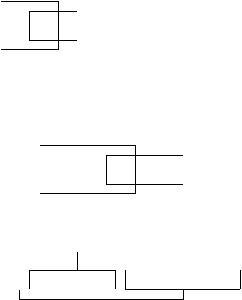
283
THE PREDICATIVE COMPLEXES
Predicative complexes (or constructions) are structures intermediate between a phrase and a clause. Unlike
phrases they contain two words I which semantically are in subject-predicate relations to one another, as one
(the nominal part) denotes the doer of the action or the bearer of the state or quality, while the other (the
predicated part) may be either verbal (an infinitive, a participle, a gerund) or non-verbal (an adjective, a stative,
an adverb, a noun). But unlike clauses the subject-predicate relations in complexes are not grammatically
explicit, that is there is no finite verb-form in them, functioning as the verbal predicate or as a link-verb of a
nominal predicate. Therefore complexes have neither real subject, nor real predicate.
Still as they have two parts with subject-predicate relations between them the complexes may be
transformed into a clause, as in:
I heard him cry ——> I heard that he cried.
Other peculirities result from their structural features:
The fact that they are devoid of the finite verb form renders them dependent on the embedding sentence, and
the very absence of the finite verb form is sufficient to show their dependent status as will be shown in the case
of different constructions:
It raining cats and dogs, we stayed at home (adverbial).
It is for you to decide it (predicative).
I saw him cross the streat. (object)
But in most cases the dependent status of the construction is manifested by special structural devices of
linking:
1. It may be overlapping (наложение) when the embedding sentence and the complex share a common
element, as in the case of objective predicative complexes:
I saw him enter this door.
where him has a double role, referring formally to the predicate of the embedding sentence (I saw him) and
referring semantically to the complex, as it denotes the doer of the action ( he entered this door); in such cases
the construction functions as one part of the sentence (a complex object).
In some cases overlapping is possible with verbs taking a preposition, then the latter is retained between the
verb and predicative comples:
We listened to him talking to his neighbour.
2. It may be blending (слияние), when elements of two structures blend into one syntactical part, usually
into а соmpound predicate of double orientation when two elements refer to
different doers of the action, as in the subjective predicative construction:
He is supposed to have arrived already —> It is supposed (they suppose) that he has arrived already.
The first part of the predicate refers to an implied doer not expressed in the sentence, though formally it
agrees with the subject he. The second part to have arrived refers to the doer expressed by the subject, though
grammatically the reference is not expressed. The elements of the complex structurally make two parts of the
sentence - the subject and part of the predicate of double orientation.
Predicative complexes comprise the following structures: subjective predicative construction, objective
predicative construction, nominative absolute predicative constructions, for-to-infinitive constructions,
gerundial complexes.
The first two constructions have permanent functions in the sentence, the functions of the last three may
vary.
Due to the nature of the second part of the constructions (verbal or non-verbal) all the constructions

